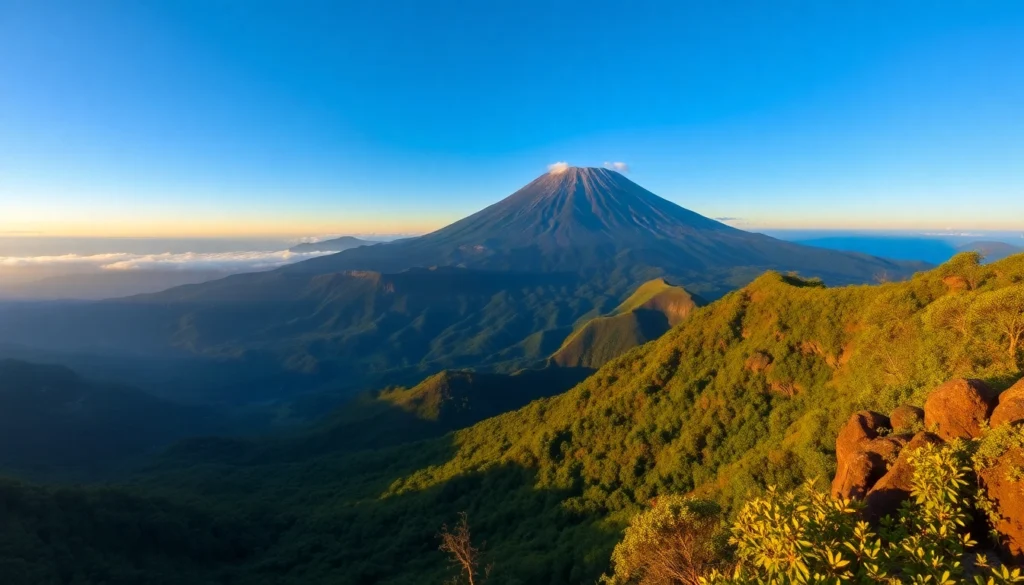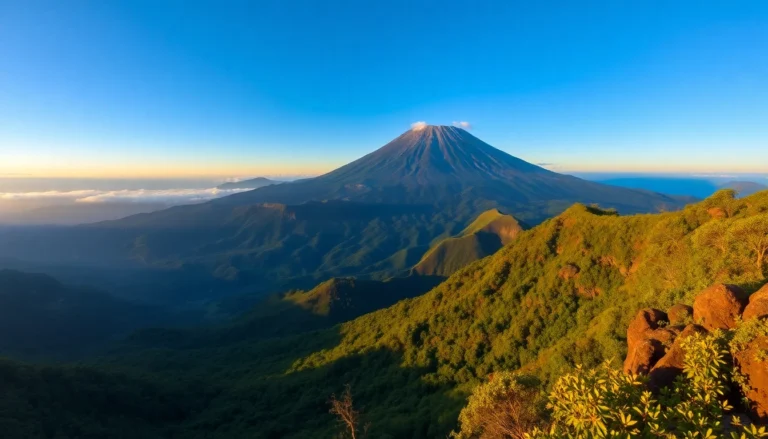
Introduction to Mt. Rinjani: Indonesia’s Iconic Volcano
Nestled on the island of Lombok in Indonesia, Mt. Rinjani stands as a majestic testament to the country’s volcanic activity and natural beauty. Rising dramatically to an elevation of 3,726 meters (12,249 feet), it is the second-highest volcano in Indonesia and one of the most revered landmarks in Southeast Asia. Known for its striking crater lake, diverse ecosystems, and vibrant cultural significance, Rinjani draws adventurers, nature lovers, and spiritual seekers from around the world.
This article delves into the rich history, geological features, trekking opportunities, practical preparation, and local attractions associated with Mt. Rinjani. Whether you are a seasoned climber or a curious traveler, understanding the nuances of this volcanic giant will empower you to plan an unforgettable journey while respecting the delicate environment and local communities.
Geographical Location and Significance
Mount Rinjani is situated within the Rinjani Volcano Complex on Lombok island, part of the West Nusa Tenggara province. It dominates the landscape, covering an area of approximately 41,330 hectares as part of the Rinjani National Park, a designated World Biosphere Reserve. The volcano is centrally located in the park, which is characterized by lush tropical rainforests, waterfalls, hot springs, and diverse flora and fauna.
Its strategic position makes it a focal point for both ecological and geological studies, as well as a cultural symbol for the Lombok people. The mountain’s prominence in the region has significant water catchment roles, feeding rivers and lakes that sustain local agriculture and ecosystems. Its spectacular silhouette also holds deep cultural importance, featuring prominently in local legends and spiritual practices.
Significance in Indonesian and Global Contexts
Indonesia is part of the Pacific “Ring of Fire,” a hotspot for volcanic activity. Rinjani’s status as an active volcano contributes to its geological importance, serving as an accessible natural laboratory for volcanologists. Furthermore, its UNESCO-recognized status and designation as a national park enhance the global appreciation of its ecological and cultural value.
Historical Eruptions and Volcanic Activity
Mt. Rinjani’s history of eruptions spans centuries, with documented activity dating back to at least the 19th century. The volcano’s most recent significant eruption occurred in 2015, producing ash plumes and lava flows that temporarily disrupted local life and air travel. Prior eruptions have shaped its landscape, creating the caldera and crater lake, known locally as Segara Anak, which is considered sacred.
Monitoring systems, including the National Geological Agency of Indonesia, continuously track seismic activity, gas emissions, and other volcanic indicators to predict potential eruptions. Despite its active status, Rinjani’s eruptions are often accompanied by warning signs, allowing timely evacuation and safety measures for trekkers and local inhabitants.
Volcanic Hazards and Safety Measures
While the risk of eruption remains, safety is prioritized through strict regulations, informed trekking routes, and real-time monitoring. Visitors are advised to check volcanic alerts before planning their hike and to heed guidance from park authorities and local guides. Understanding the volcano’s behavior and respecting its power are key to safe exploration.
Why Mt. Rinjani Is a Must-Visit Destination
Beyond its geological significance, Mt. Rinjani offers an extraordinary blend of adventure, natural beauty, cultural immersion, and serenity. Its scenic vistas include panoramic mountain views, lush valleys, hot springs, and the iconic Segara Anak crater lake with its vibrant blue hues.
The trekker’s journey often culminates in witnessing sunrise from summit viewpoints, exploring the diverse ecosystems, and soaking in the hot springs. The cultural elegance of the local Sasak and Balinese communities, along with the spiritual aura surrounding Rinjani, makes it an inspiring destination for travelers seeking meaningful experiences amidst pristine landscapes.
Ecotourism and Community Engagement
Efforts to promote sustainable tourism and community-based initiatives have enhanced Rinjani’s reputation. Visitors can participate in cultural tours, stay in eco-lodges, and support local guides, ensuring that tourism benefits the surrounding communities. Respectful engagement helps conserve the environment and enrich the visitor experience.
Planning Your Rinjani Trek: Preparation and Tips
Best Seasons and Timing for Trekking
Choosing the right time to undertake the Rinjani trek is vital. The dry season, from April to October, offers clear skies, cooler temperatures, and optimal conditions for hiking. The peak months are June and July, but these also see higher tourist influx.
Rainy seasons (November to March) typically bring unpredictable weather, muddy trail conditions, and increased safety risks. Therefore, planning your trek during the dry season maximizes safety, comfort, and visibility of scenic vistas.
Essential Equipment and Clothing
Preparation involves meticulous packing, focusing on safety and comfort. Essential gear includes:
- Sturdy hiking boots with ankle support
- Warm clothing layers (fleece, thermal wear)
- Windproof and waterproof jacket
- Hat, sunglasses, and sunscreen
- Backpack with rain cover
- Sleeping bag suitable for cold temperatures
- Headlamp or flashlight with extra batteries
- Personal medication and first aid kit
Since temperatures can drop below freezing at higher elevations, packing adequate thermal wear and windproof gear is crucial. Technical trekking poles can aid stability on steep sections.
Costs, Guides, and Permits
Understanding the financial scope and logistical requirements is essential. The overall budget includes park entry fees (~IDR 200,000), guide and porter services (~IDR 1,400,000 for guides and around IDR 1,200,000 for porters for a typical 3-4 day trek), accommodation, food, and equipment rental.
Guides are mandatory for safety, cultural insights, and environmental protection. Permit procurement is managed via the local park office or authorized agencies. It’s advisable to book guided tours well in advance to secure availability and ensure proper arrangements.
Trail Routes and Popular Trekking Areas
Sembalun Valley Route
The most popular and accessible route begins at Sembalun Lawang, offering breathtaking views of surrounding hills and rice terraces. The trail ascends gradually through savannahs and forests, leading trekkers to the crater rim with panoramic views of Segara Anak lake. This route is favored for its well-maintained paths and relatively easier ascent for beginners.
Senaru Crater Lake Path
Starting from the village of Senaru, this route offers lush jungle scenery, waterfalls, and a more challenging ascent. The trail includes crossing lava fields and the crater rim, with opportunities to visit hot springs and explore the caldera’s interior. It’s suited for advanced trekkers and those seeking a more rugged experience.
Advanced Climbing and Alternative Trails
Certain routes, such as the summit climb via the Segara Anak caldera or alternative paths, are reserved for experienced mountaineers. These may involve technical sections, snow or ice at higher altitudes, and require specialized equipment and guides. Proper training and preparation are essential for tackling these routes safely.
Things to Know Before Your Rinjani Adventure
Physical Fitness and Safety Tips
Climbing Mt. Rinjani is physically demanding, often involving steep ascents, variable terrain, and altitude sickness risk. A recommended fitness routine includes cardio training, strength exercises, and altitude adaptation practices before the trek. Most importantly, acclimatize properly by gradually ascending and staying hydrated.
Safety measures include listening to your guide, avoiding overexertion, and being prepared for sudden weather changes. Emergency protocols involve evacuation plans, medical kits, and communication devices—ensure these are in place.
Environmental Conservation and Responsible Tourism
Rinjani’s ecosystem is fragile. Visitors must adhere to Leave No Trace principles, such as packing out all waste, staying on designated trails, and avoiding damage to vegetation and wildlife. Supporting local guides and accommodations that prioritize eco-friendly practices further sustains the environment.
Local Culture and Hospitality
The local Sasak and Balinese communities enrich the Rinjani experience. Respect for their traditions, dress codes, and customs is essential. Engaging with local guides not only enhances安全 but also promotes cultural exchange and economic support for the community.
Post-Trek Highlights: What to Experience in Lombok
Nearby Attractions and Waterfalls
After conquering the mountain, explore Lombok’s stunning waterfalls such as Sendang Gile and Tiu Kelep, located near Senaru. These natural attractions offer refreshing escapes and picturesque scenery amidst lush jungle landscapes.
Other notable sites include the Gili islands—Gili Trawangan, Gili Air, and Gili Meno—famous for beautiful beaches, snorkeling, and vibrant nightlife.
Local Cuisine and Cultural Spots
Relish Lombok’s authentic dishes like Ayam Taliwang (spicy grilled chicken), Plecing Kangkung (water spinach salad), and fresh seafood. Visiting local markets and traditional villages offers insights into Sasak culture and craftsmanship, including weaving, pottery, and dance performances.
Booking Tours and Connecting with Guides
For a seamless experience, engage with reputable tour operators and guides. Many offer comprehensive packages that include transport, permits, equipment, and expert guiding. Online platforms and local agencies facilitate pre-booking, while onsite connections ensure flexibility and personalized attention.



